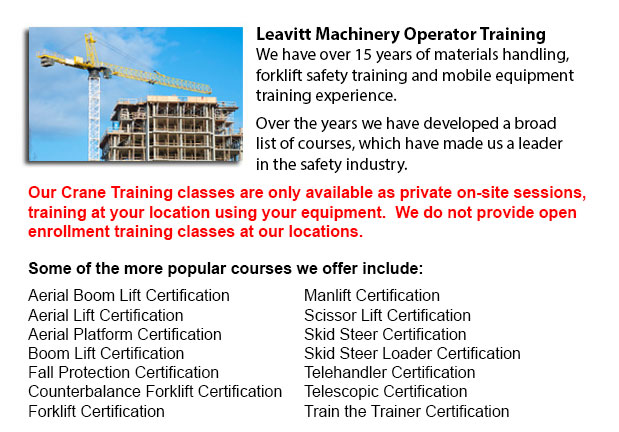
Overhead Crane Safety Training Vaughan - Overhead crane safety training equips operators with skills and knowledge regarding crane safety measures, accident avoidance, materials handling, and equipment and stock protection. Trainees would learn the types of overhead cranes, their capabilities and their uses in various industry settings. For operators who are trained and licensed, the shift in liability moves from the company to the operator. Therefore, the course emphasizes individual operator duties.
Overhead crane safety training instructs operators in the right techniques for carrying out checks. Two kinds of pre-shift check are the walk-around inspection and the in-depth inspection. These are important daily routines that must be logged. Correctly recorded pre-shift checks help to protect the business from liability in the event of an accident. Pre-shift checks likewise prevent expensive repairs, accidents and damage. Operators learn how to designate a particular individual to perform inspections, how to report problems, and how to maintain the log book.
Inspections must be performed regularly and documented properly. The following must checked while watching for usual problems: hooks for cracks, increases in the throat opening, hoist ropes for corrosion, degree of twist, worn wires, loss of diameter, bird caging and kinks, broken wires, chains for nicks and gouges, heat and chemical damage, twists, cracks and corrosion, distortion, excessive wear, stretching, pits, damage caused by extreme heat.
The operator will get to learn the right techniques about correct rigging measures. The process of rigging involves the understanding of the manufacturer's data plate, determining the material weight to be lifted, selecting the gear, and utilizing safe practices to secure the load. The course cover in detail the following: safe working loads, and the capacities of chains, ropes, slings, hooks and shackles.
It is vital to understand who could utilize the cranes at your facility, physical requirements of the job, and operator credentials needed for specialized job and permits. Safety is a priority when using in the vicinity of pedestrian traffic.
The duties involved in the safe crane utilization includes undertaking visual inspections, checking for hydraulic leaks, testing the controls, checking the safety guards, examining the hoist rope and hook, braking mechanisms and limit switches. Right reporting methods are vital. These topics are all included in depth in the program.
Proper lifting and moving procedures with cranes and hoists are included in the course. Operators would become skilled in hand signals. Training involves how to attach the load, raise the load, unhook the slings, abort a lift and set the load.
The steps involved with moving the load, consists of: starting and stopping procedures, guiding and controlling the load, observing working conditions and working with signals. In the event of power failures, the operator would have to know how to proceed. The course includes methods for lowering the load and removing the slings, parking the crane, storage equipment, and securing an outdoor and indoor crane.
-
Forklift License Vaughan
Forklift License Vaughan - Getting a forklift certification or forklift license in North America would require the trainee to do hands-on training in addition to classroom instruction. The provincial, federal and state regulatory bodies are responsib... More -
Forklift Ticket Vaughan
Forklift Ticket Vaughan - Forklifts and the pallet jack is meant for just about the same reason. They work to raise and move supplies and goods from one place to another. This however is where the comparison stops though. With the pallet jack, the be... More -
Aerial Lift Certification Vaughan
Aerial Lift Certification Vaughan - Aerial Lift Certification is for individuals who need an in-depth understanding of aerial lift safety. Operators and inspectors, supervisors, maintenance workers and construction craftsmen should perform a certific... More -
Manlift Certification Vaughan
Manlift Certification Vaughan - The Manlifts and Elevated Platforms course provides training on the rules, regulations and proper application of safe operating measures and work practices included in everyday activities for those who work making use... More -
Heavy Equipment Training Vaughan
Heavy Equipment Training Vaughan - The two most common kinds of heavy equipment training are categorized into the categories of machines; equipment that is fashioned with rubber tires or those with tracks. The tracked vehicle are heavy duty machines... More -
Boom Lift Ticket Vaughan
Boom Lift Ticket Vaughan - Boom lifts are equipment that has a platform that may be lowered or raised to different heights, thus making this piece of equipment an important necessity in a wide variety of professions. Offered in many different particu... More -
Telehandler License Vaughan
Telehandler License Vaughan - The telescopic handler or telehandler is a frequently used equipment in industrial and agricultural applications. This particular machine is the same in appearance to a forklift and also functions in a similar way, altho... More -
Scissor Lift Training Vaughan
Scissor Lift Training Vaughan - Scissor lifts have to be operated competently to be able to protect the safety of the machinery and the safety of others within the workplace. Operators who are skilled are trained to drive the particular kind of sciss... More

Forklift Training Vaughan
TOLL FREE: 1-888-254-6157
Vaughan, Ontario
forklifttrainingvaughan.com
Email Us
About Us


